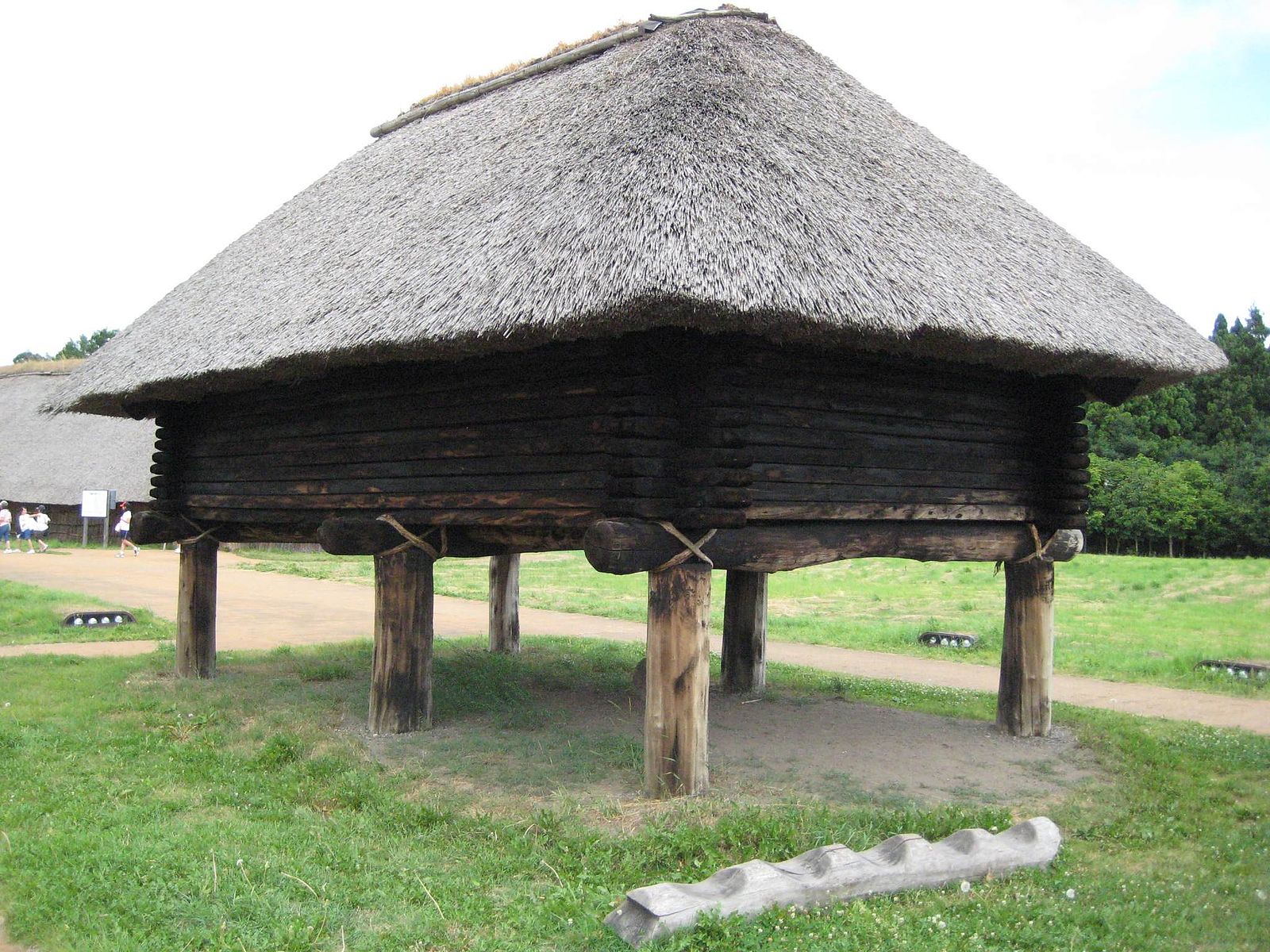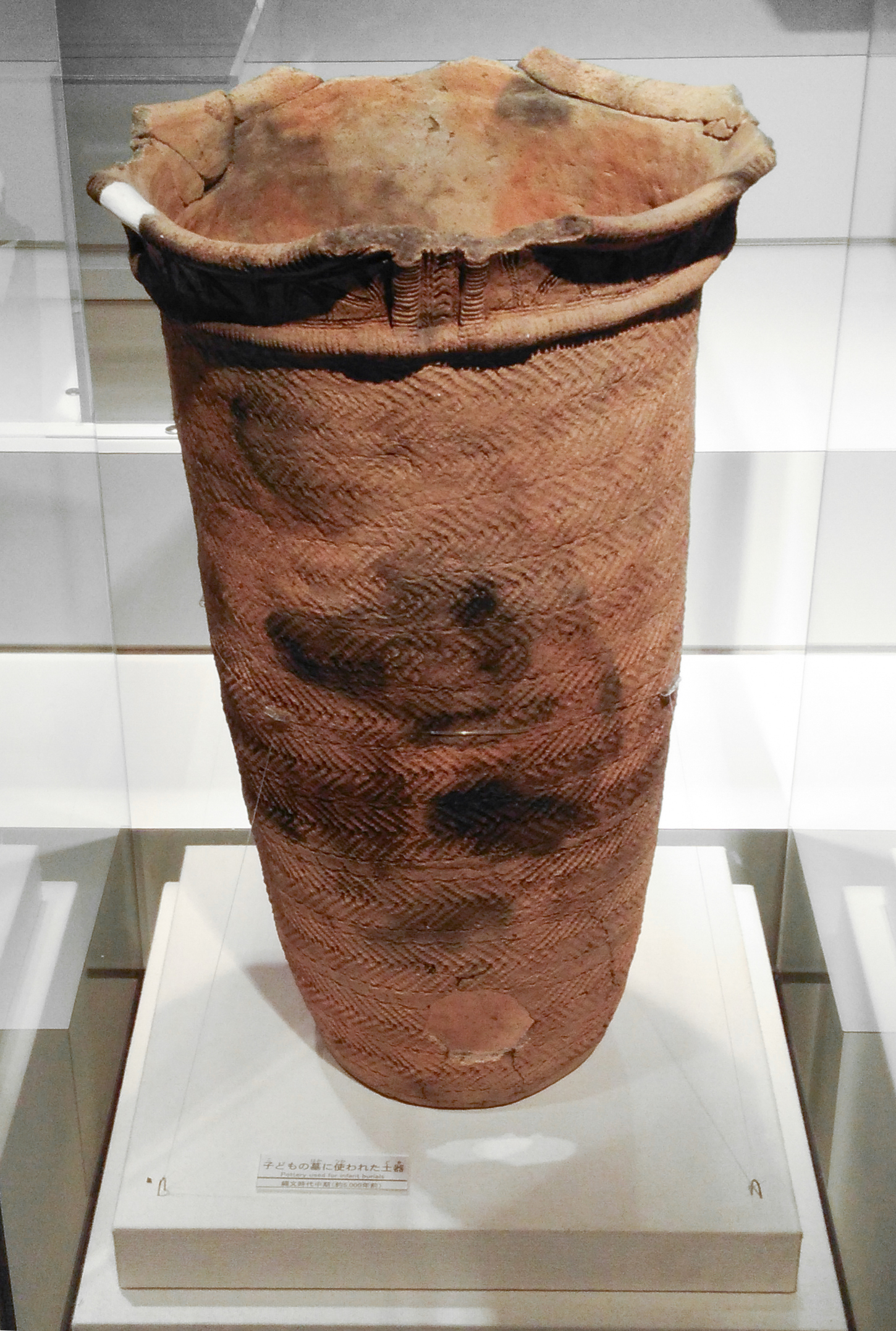2.4: Early Jomon (5000 BCE – 2500 BCE)
- Page ID
- 219957
\( \newcommand{\vecs}[1]{\overset { \scriptstyle \rightharpoonup} {\mathbf{#1}} } \)
\( \newcommand{\vecd}[1]{\overset{-\!-\!\rightharpoonup}{\vphantom{a}\smash {#1}}} \)
\( \newcommand{\id}{\mathrm{id}}\) \( \newcommand{\Span}{\mathrm{span}}\)
( \newcommand{\kernel}{\mathrm{null}\,}\) \( \newcommand{\range}{\mathrm{range}\,}\)
\( \newcommand{\RealPart}{\mathrm{Re}}\) \( \newcommand{\ImaginaryPart}{\mathrm{Im}}\)
\( \newcommand{\Argument}{\mathrm{Arg}}\) \( \newcommand{\norm}[1]{\| #1 \|}\)
\( \newcommand{\inner}[2]{\langle #1, #2 \rangle}\)
\( \newcommand{\Span}{\mathrm{span}}\)
\( \newcommand{\id}{\mathrm{id}}\)
\( \newcommand{\Span}{\mathrm{span}}\)
\( \newcommand{\kernel}{\mathrm{null}\,}\)
\( \newcommand{\range}{\mathrm{range}\,}\)
\( \newcommand{\RealPart}{\mathrm{Re}}\)
\( \newcommand{\ImaginaryPart}{\mathrm{Im}}\)
\( \newcommand{\Argument}{\mathrm{Arg}}\)
\( \newcommand{\norm}[1]{\| #1 \|}\)
\( \newcommand{\inner}[2]{\langle #1, #2 \rangle}\)
\( \newcommand{\Span}{\mathrm{span}}\) \( \newcommand{\AA}{\unicode[.8,0]{x212B}}\)
\( \newcommand{\vectorA}[1]{\vec{#1}} % arrow\)
\( \newcommand{\vectorAt}[1]{\vec{\text{#1}}} % arrow\)
\( \newcommand{\vectorB}[1]{\overset { \scriptstyle \rightharpoonup} {\mathbf{#1}} } \)
\( \newcommand{\vectorC}[1]{\textbf{#1}} \)
\( \newcommand{\vectorD}[1]{\overrightarrow{#1}} \)
\( \newcommand{\vectorDt}[1]{\overrightarrow{\text{#1}}} \)
\( \newcommand{\vectE}[1]{\overset{-\!-\!\rightharpoonup}{\vphantom{a}\smash{\mathbf {#1}}}} \)
\( \newcommand{\vecs}[1]{\overset { \scriptstyle \rightharpoonup} {\mathbf{#1}} } \)
\( \newcommand{\vecd}[1]{\overset{-\!-\!\rightharpoonup}{\vphantom{a}\smash {#1}}} \)
\(\newcommand{\avec}{\mathbf a}\) \(\newcommand{\bvec}{\mathbf b}\) \(\newcommand{\cvec}{\mathbf c}\) \(\newcommand{\dvec}{\mathbf d}\) \(\newcommand{\dtil}{\widetilde{\mathbf d}}\) \(\newcommand{\evec}{\mathbf e}\) \(\newcommand{\fvec}{\mathbf f}\) \(\newcommand{\nvec}{\mathbf n}\) \(\newcommand{\pvec}{\mathbf p}\) \(\newcommand{\qvec}{\mathbf q}\) \(\newcommand{\svec}{\mathbf s}\) \(\newcommand{\tvec}{\mathbf t}\) \(\newcommand{\uvec}{\mathbf u}\) \(\newcommand{\vvec}{\mathbf v}\) \(\newcommand{\wvec}{\mathbf w}\) \(\newcommand{\xvec}{\mathbf x}\) \(\newcommand{\yvec}{\mathbf y}\) \(\newcommand{\zvec}{\mathbf z}\) \(\newcommand{\rvec}{\mathbf r}\) \(\newcommand{\mvec}{\mathbf m}\) \(\newcommand{\zerovec}{\mathbf 0}\) \(\newcommand{\onevec}{\mathbf 1}\) \(\newcommand{\real}{\mathbb R}\) \(\newcommand{\twovec}[2]{\left[\begin{array}{r}#1 \\ #2 \end{array}\right]}\) \(\newcommand{\ctwovec}[2]{\left[\begin{array}{c}#1 \\ #2 \end{array}\right]}\) \(\newcommand{\threevec}[3]{\left[\begin{array}{r}#1 \\ #2 \\ #3 \end{array}\right]}\) \(\newcommand{\cthreevec}[3]{\left[\begin{array}{c}#1 \\ #2 \\ #3 \end{array}\right]}\) \(\newcommand{\fourvec}[4]{\left[\begin{array}{r}#1 \\ #2 \\ #3 \\ #4 \end{array}\right]}\) \(\newcommand{\cfourvec}[4]{\left[\begin{array}{c}#1 \\ #2 \\ #3 \\ #4 \end{array}\right]}\) \(\newcommand{\fivevec}[5]{\left[\begin{array}{r}#1 \\ #2 \\ #3 \\ #4 \\ #5 \\ \end{array}\right]}\) \(\newcommand{\cfivevec}[5]{\left[\begin{array}{c}#1 \\ #2 \\ #3 \\ #4 \\ #5 \\ \end{array}\right]}\) \(\newcommand{\mattwo}[4]{\left[\begin{array}{rr}#1 \amp #2 \\ #3 \amp #4 \\ \end{array}\right]}\) \(\newcommand{\laspan}[1]{\text{Span}\{#1\}}\) \(\newcommand{\bcal}{\cal B}\) \(\newcommand{\ccal}{\cal C}\) \(\newcommand{\scal}{\cal S}\) \(\newcommand{\wcal}{\cal W}\) \(\newcommand{\ecal}{\cal E}\) \(\newcommand{\coords}[2]{\left\{#1\right\}_{#2}}\) \(\newcommand{\gray}[1]{\color{gray}{#1}}\) \(\newcommand{\lgray}[1]{\color{lightgray}{#1}}\) \(\newcommand{\rank}{\operatorname{rank}}\) \(\newcommand{\row}{\text{Row}}\) \(\newcommand{\col}{\text{Col}}\) \(\renewcommand{\row}{\text{Row}}\) \(\newcommand{\nul}{\text{Nul}}\) \(\newcommand{\var}{\text{Var}}\) \(\newcommand{\corr}{\text{corr}}\) \(\newcommand{\len}[1]{\left|#1\right|}\) \(\newcommand{\bbar}{\overline{\bvec}}\) \(\newcommand{\bhat}{\widehat{\bvec}}\) \(\newcommand{\bperp}{\bvec^\perp}\) \(\newcommand{\xhat}{\widehat{\xvec}}\) \(\newcommand{\vhat}{\widehat{\vvec}}\) \(\newcommand{\uhat}{\widehat{\uvec}}\) \(\newcommand{\what}{\widehat{\wvec}}\) \(\newcommand{\Sighat}{\widehat{\Sigma}}\) \(\newcommand{\lt}{<}\) \(\newcommand{\gt}{>}\) \(\newcommand{\amp}{&}\) \(\definecolor{fillinmathshade}{gray}{0.9}\)Introduction
In the Jomon Period of Japan, some small permanent settlements were established, yet they continued to be hunter-gatherers. Their houses were shallow pit houses in groups of 10-12 homes per site. Although agriculture was not evident in the early Jomon civilization, they had plentiful hunting (deer, boar), gathering (nuts, berries, fruits), and fishing and mollusks. The separation of Japan from the Asian mainland possibly kept the civilization a hunter/gatherer society instead of evolving into a farming society like China. It also may account for the lack of invasion by other civilizations, keeping the Jomon in their current hunter/gatherer state as the Early Jomon started the transition to farming around 5000 BCE.

The Jomon technique refers to the special method used by an ancient civilization to make and decorate their pottery (2.4.1). These containers, dating back to 13,000 BCE, are some of the oldest found around the world. The early Jomon culture lasted for a long period of time, starting around 14,000 BCE when people migrated across land bridges after the Ice Age. As temperatures rose, these pathways disappeared, causing the Jomon people to become isolated. They developed a unique civilization that continued through the Incipient, Early, Middle, Late, and Final Jomon periods.
"Jyoumon" translates to patterns of cord.”
One of the oldest Jomon sites is in Kasori, near Tokyo. The site included a large shell midden (discarded shell mounds), debris piles like our modern dumps giving researchers a window into food sources, and daily living materials seen in the uniquely decorated pottery for practical use for cooking and storing. Much of the information from the Jomon period is speculation based on artifacts. Although the Jomon did not have a written language it is considered Japan's first primary culture. Excavation at the Sannai-Maruyama archeological site in Japan revealed a large prehistoric town. They found fishing hooks, spears, net sinkers, and dugout canoes during the excavation. A paw print indicated that the Jomon might have had dogs as pets.
Approximately 5000 BCE marked the emergence of coastal settlements and the formation of communities, where hunting and gathering were the primary means of sustenance. The abundance of food sources in these regions enabled individuals to obtain fish and mollusks from the oceans, fruits, nuts, and acorns from trees, and boar and deer from the land. Notably, early Jomon villages were found to possess extensive shell mounds containing oysters, clams, and other mollusks used for both culinary and ceremonial purposes. In colder regions, larger shell mounds were observed, indicating that these communities relied heavily on the sea for sustenance. In the southern sections of the country, researchers found further evidence of edible plants and animals.
As people established communal groups and food became plentiful, they transitioned from cave living to constructed buildings. At the very beginning of the Jomon era (10,000-8,000 B.C.), the Jomon hunter-gatherers lived in caves or rock shelters like people during the Paleolithic era did. Very soon however, the Jomon people learnt to build and to live in pit dwellings. And for nearly 10,000 years, and even into the next Yayoi era, pit dwellings continued to be the basic kind of home for people.[1]
Architecture
Thousands of pit dwellings have been unearthed at excavation sites in Japan, particularly near tidal flats along the Pacific Ocean. These pit houses were arranged in a horseshoe pattern around a large communal area that served as a hub for activities such as tool or pottery-making, food preparation, burial grounds, and ceremonial purposes. The main staple of the Jomon diet was the chestnut, and archeologists discovered large chestnut orchards in the Sannai-Maruyama area. They used the tree's wood for building, and one surviving structure was supported by six large chestnut logs and stood three stories high. Jomon houses were labeled pit houses because they were dug down, similar to having a basement but only one level. The first houses had one central support pole round in size, evolving into a square shape with six support posts, the main beam, and thatched grass roofs. The floors are made of earth and stone, similar to cobblestone walkways, the indoor fire pits providing warmth and a place to cook.
_houses.jpg?revision=1&size=bestfit&width=737&height=552)
At Hira-ide Park, visitors can see a reconstruction of these pit houses (2.4.2) as they appeared in 3000 BCE. The houses were built as shallow pits in the ground, supported by chestnut tree posts and a thatched roof. The houses were kept warm in winter by pressing the earth down almost a meter below ground level. Each dwelling featured a central fireplace used for cooking, smoking meat and fish, and warmth. With enough room to accommodate up to five people, each house also had storage areas for pots, traps, snares, and some stone tools. The Sannai-Maruyama settlement is the largest settlement archaeologists have discovered in Japan. The settlers lived in pit houses and stored their food in pits or the elevated buildings (2.4.3). During excavation, long houses (2.4.4) or large oval shaped buildings were found, and historians believe they were used for meeting places or workshops. The tall platform was a set of pillars with wooden platforms. The use of the platform is unknown. The Jomon used wood from the chestnut trees found in the region and thatching for the roofs. The location also had two large midden sites filled with empty shells and other artifacts, all acting as the local dump. During excavations, over 500 burial sites were found with adult remains and jar burials for small children. Tools, clay figures, pottery, baskets, and wood products were found in abundance.


Art
Pots were the primary form of creative expression for the Jomon civilization for thousands of years. Numerous pots have been discovered throughout Japan, dating back to 12,000 BCE. Most of the long Jomon era pots were decorated with the 'cord pattern.' The earliest pots were primitive looking and used for cooking. The rounded bottoms (2.4.5), made it easier for the vessels to sit comfortably in the coals of the fire pit.
“Children were placed in pottery and buried after death. Approximately 900 tombs have been found in Sannai Maruyama. Pottery used as coffins had a round hole or a broken rim or bottom, being differentiated from those used for cooking. A fist-size stone was found in one of the pottery.”[2]
During excavations at Sannai Maruyama, archaeologists unearthed various artifacts and features, including large pit dwellings, postholes, and pottery. Among the discoveries were infant burial jars, ceramic vessels explicitly used for the burial of infants. The Jomon people were renowned for their intricate cord-marked pottery, which came in various shapes and sizes. The infant burial jars found at Sannai Maruyama boasted unique decorative elements, making them highly valuable cultural and archaeological artifacts that offer a glimpse into the burial customs and daily life of the Jomon people. These burial jars (2.4.6) provide valuable insight into this ancient society's cultural and religious practices and their treatment of infants in death. The Jomon period spanned a significant period of Japan's prehistory, from around 14,000 BCE to 300 BCE, and the Sannai Maruyama site is a crucial source of information about this fascinating era of history. These simpler pots represent some of the earliest examples of pottery found in any culture.

The Jomon were the first to make clay vessels, and some date to 10,000 BCE. Around 3100 BCE, the Jomon people began making clay vessels in different shapes. They created unique patterns in the wet clay by imprinting it with coiled rope and sticks. The pots were initially coil pots made with clay coils starting at the bottom and molded to form a pot. Once the pot was smooth, they pressed a cord into the wet or damp clay, creating cord markings. There are hundreds of different designs on the pots, a reflection of people's desire to create beyond the practical use of a pot. Pottery was dried and then fired in a low-temperature bonfire. In the later years of the Jomon Period, the corded imprints on the vessels started to disappear, replaced by the form and function of a pot.
Around 5000 BCE, jars and vessels with flat bottoms were developed for storage inside houses on flat earth, rather than just for cooking. These pots were created using the coil method, which involved using soft clay and did not require a potter's wheel. To add texture and variety, makers would sometimes mix in different materials, such as fibers or crushed shells. Once the pot was smoothed, the maker would add decorative elements, using strips of hide, twigs, or other materials to create the signature cord pattern. The vessel (2.4.7) demonstrates the elaborate ornamentation added to the pottery by 3000 BCE. Additional pieces along the top give the vessel flame-like fingers and reflected the artistic abilities of the maker.
 Figure \(\PageIndex{7}\): Vessel with Flame-like Ornamentation (Daderot, CC0)
Figure \(\PageIndex{7}\): Vessel with Flame-like Ornamentation (Daderot, CC0)Bonfires were built to fire the dried pots, and multiple pots were placed in the fire and left to harden. Very few bowls were found in the Early Jomon era, mostly in graves for some type of ritual. Some evidence exists that the people traded vessels between local communities. Still, because the vessels were similar, they probably traded what was stored in the vessel, not the pottery itself.
The Jomon people did not weave any fabric to make their clothes. Instead, they used mulberry bark and animal bone needles to sew the pieces together. They also made simple decorative ornaments from shells and bones using stone tools. Like other Neolithic cultures, the Jomon crafted their tools using wood and attached smoothed, polished stones to create axes, knives, and harpoons. However, during this period, they did not cultivate the land or manufacture large-scale tools required for agriculture. Archaeologists have discovered a few simple clay figures during excavations, but their purpose remains unknown. These figures were hand-formed and fired in open pit fires like pottery, with the face and features sculpted by hand.
The Jomon people thrived for many centuries by relying on the bounties of the sea and the forest. They adeptly utilized these resources while living in seclusion from other societies, allowing their exceptional vessels to persist. Their pottery designs were especially renowned and admired for their elaborate and exquisite patterns.


